| This article needs additional citations for verification. Please help improve this article by adding citations to reliable sources. Unsourced material may be challenged and removed. Find sources: "Volute" – news · newspapers · books · scholar · JSTOR (June 2018) (Learn how and when to remove this message) |

A volute is a spiral, scroll-like ornament that forms the basis of the Ionic order, found in the capital of the Ionic column. It was later incorporated into Corinthian order and Composite column capitals. Four are normally to be found on an Ionic capital, eight on Composite capitals and smaller versions (sometimes called helix) on the Corinthian capital.
The word derives from the Latin voluta ("scroll"). It has been suggested that the ornament was inspired by the curve of a ram's horns, or perhaps was derived from the natural spiral found in the ovule of a common species of clover native to Greece. Alternatively, it may simply be of geometrical origin.
The ornament can be seen in Renaissance and Baroque architecture and is a common decoration in furniture design, silverware and ceramics. A method of drawing the complex geometry was devised by the ancient Roman architect Vitruvius through the study of classical buildings and structures.
Gallery
-
Prehistoric Cucuteni–Trypillia volutes on some vessels, c.4300–4000 BC, ceramic, Moldavia National Museum Complex, Iași, Romania
-
 Cycladic volutes on a 'frying pan', c.2750-2200 BC, ceramic, National Archaeological Museum, Athens
Cycladic volutes on a 'frying pan', c.2750-2200 BC, ceramic, National Archaeological Museum, Athens
-
Sumerian volutes at the end of a bull mascaron of the queen's lyre, one of the Lyres of Ur, 2600 BC, wood, lapis lazuli, limestone (red), bitumen, gold, shell, British Museum
-
 Minoan volutes on a jug, c.1850-1675 BC, ceramic, Archaeological Museum of Heraklion, Heraklion, Greece
Minoan volutes on a jug, c.1850-1675 BC, ceramic, Archaeological Museum of Heraklion, Heraklion, Greece
-
 Minoan volutes on a sceptre head, c.1675-1460 BC, schist, Archaeological Museum of Heraklion
Minoan volutes on a sceptre head, c.1675-1460 BC, schist, Archaeological Museum of Heraklion
-
 Ancient Egyptian volutes on a ceiling painting from the palace of Amenhotep III, c.1390–1353 BC, dried mud, mud plaster and paint Gesso, Metropolitan Museum of Art, New York City
Ancient Egyptian volutes on a ceiling painting from the palace of Amenhotep III, c.1390–1353 BC, dried mud, mud plaster and paint Gesso, Metropolitan Museum of Art, New York City
-
 Mycenaean volutes, part of a mural from a palace in Tiryns, Greece, 13th century BC, fresco, Archaeological Museum of Nafplion, Nafplio, Greece
Mycenaean volutes, part of a mural from a palace in Tiryns, Greece, 13th century BC, fresco, Archaeological Museum of Nafplion, Nafplio, Greece
-
 Ancient Egyptian amulet of Thoth as a baboon holding an eye of Horus, with a volute in the lower left part of the eye, 664-332 BC, Egyptian faience with light green glaze, Walters Art Museum, Baltimore, Maryland, US
Ancient Egyptian amulet of Thoth as a baboon holding an eye of Horus, with a volute in the lower left part of the eye, 664-332 BC, Egyptian faience with light green glaze, Walters Art Museum, Baltimore, Maryland, US
-
 Ancient Greek pair of volutes at the base of the handle of a patera, 6th century BC, bronze, National Archaeological Museum, Athens
Ancient Greek pair of volutes at the base of the handle of a patera, 6th century BC, bronze, National Archaeological Museum, Athens
-
 Neo-Babylonian volutes on the wall panel from the Throne Room of Nebuchadnezzar II from Babylon, Iraq, 6th century BC, glazed ceramic, Pergamon Museum, Berlin
Neo-Babylonian volutes on the wall panel from the Throne Room of Nebuchadnezzar II from Babylon, Iraq, 6th century BC, glazed ceramic, Pergamon Museum, Berlin
-
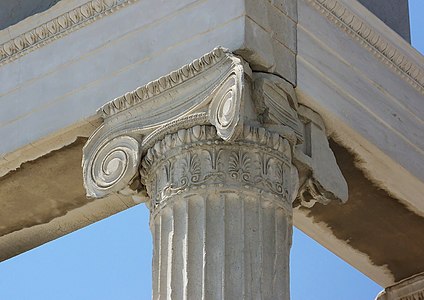 Ancient Greek volutes of a capital from an Ionic columns of the Erechtheion, Athens, Greece, unknown architect, 421-405 BC
Ancient Greek volutes of a capital from an Ionic columns of the Erechtheion, Athens, Greece, unknown architect, 421-405 BC
-
 Ancient Greek volutes of a corbel of the Erechtheion
Ancient Greek volutes of a corbel of the Erechtheion
-
 Ancient Greek volutes on a krater, by the Painter of the Woolly Satyrs, 450–440 BC, ceramic, Louvre
Ancient Greek volutes on a krater, by the Painter of the Woolly Satyrs, 450–440 BC, ceramic, Louvre
-
 Ancient Greek volutes (called caulicoli) in the upper part of a Corinthian capital from the tholos at Epidaurus, Archaeological Museum of Epidaurus, Greece, said to have been designed by Polyclitus the Younger, c.350 BC
Ancient Greek volutes (called caulicoli) in the upper part of a Corinthian capital from the tholos at Epidaurus, Archaeological Museum of Epidaurus, Greece, said to have been designed by Polyclitus the Younger, c.350 BC
-
 Ancient Greek pair of volutes on an akroterion, 350–325 BC, marble, Metropolitan Museum of Art
Ancient Greek pair of volutes on an akroterion, 350–325 BC, marble, Metropolitan Museum of Art
-
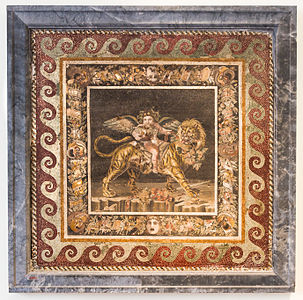 Roman volutes around a mosaic of young Dionysos drinking and riding a tiger, late 4th century BC, mosaic, National Archaeological Museum, Naples, Italy
Roman volutes around a mosaic of young Dionysos drinking and riding a tiger, late 4th century BC, mosaic, National Archaeological Museum, Naples, Italy
-
 Ancient Greek foliage volutes (aka rinceaux) on a capital from the ruins of the Temple of Apollo at Didyma, Turkey, unknown architect or sculptor, c.300-150 BC
Ancient Greek foliage volutes (aka rinceaux) on a capital from the ruins of the Temple of Apollo at Didyma, Turkey, unknown architect or sculptor, c.300-150 BC
-
 Roman volute of an Ionic capital, 1st century BC or AD, unknown stone, Antiquarium di Milano, Milan, Italy
Roman volute of an Ionic capital, 1st century BC or AD, unknown stone, Antiquarium di Milano, Milan, Italy
-
 Roman foliage volutes in an arabesque on the Ara Pacis, Rome, unknown architect and sculptors, 13-9 BC
Roman foliage volutes in an arabesque on the Ara Pacis, Rome, unknown architect and sculptors, 13-9 BC
-
 Buddhist volutes on the Great Stupa of Sanchi (Madhya Pradesh, India), unknown architect, 3rd century-c.100 BC
Buddhist volutes on the Great Stupa of Sanchi (Madhya Pradesh, India), unknown architect, 3rd century-c.100 BC
-
 Roman volutes at the top of a funerary altar, 25-50 AD, marble, Terme di Diocleziano, Rome
Roman volutes at the top of a funerary altar, 25-50 AD, marble, Terme di Diocleziano, Rome
-
 Ancient Egyptian volutes on a Composite capital from Trajan's Kiosk, Agilkia Island, Egypt, 98-117, unknown architect
Ancient Egyptian volutes on a Composite capital from Trajan's Kiosk, Agilkia Island, Egypt, 98-117, unknown architect
-
 Roman volutes of Composite capitals of the Library of Celsus, Ephesus, Turkey, unknown architect, c.110
Roman volutes of Composite capitals of the Library of Celsus, Ephesus, Turkey, unknown architect, c.110
-
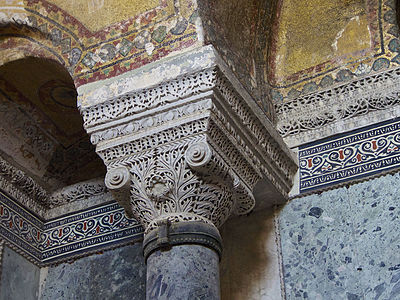 Byzantine volutes of an Ionic capital in the Hagia Sophia, Istanbul, Turkey, by Anthemius of Tralles or Isidore of Miletus, 6th century
Byzantine volutes of an Ionic capital in the Hagia Sophia, Istanbul, Turkey, by Anthemius of Tralles or Isidore of Miletus, 6th century
-
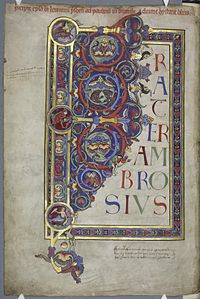 Romanesque foliage volutes on a page from the Bury Bible, by Master Hugo, c.1135-1140, illumination on parchment, Corpus Christi College, University of Cambridge, the UK
Romanesque foliage volutes on a page from the Bury Bible, by Master Hugo, c.1135-1140, illumination on parchment, Corpus Christi College, University of Cambridge, the UK
-
 Gothic volutes on the wrought-iron on a door of Notre Dame de Paris, unknown architect or blacksmith, 12th or 13th centuries
Gothic volutes on the wrought-iron on a door of Notre Dame de Paris, unknown architect or blacksmith, 12th or 13th centuries
-
 Renaissance volutes of the Sant'Agostino, Rome, by multiple architects, 1483
Renaissance volutes of the Sant'Agostino, Rome, by multiple architects, 1483
-
Renaissance volutes on a cassone, 16th century, most probably walnut, Villa medicea di Cerreto Guidi, Cerreto Guidi, Italy
-
 Renaissance stucco volutes on the ceiling from the King's Staircase, Palace of Fontainebleau, France, by Francesco Primaticcio, c.1541-1545
Renaissance stucco volutes on the ceiling from the King's Staircase, Palace of Fontainebleau, France, by Francesco Primaticcio, c.1541-1545
-
 Baroque volutes on the upper part of the facade of the Church of the Gesù, Rome, by Giacomo della Porta, 1584
Baroque volutes on the upper part of the facade of the Church of the Gesù, Rome, by Giacomo della Porta, 1584
-
 Northern Renaissance volutes on the Leisthaus, Hamelin, Germany, by the master builder Cord Tönnis, 1585-1589
Northern Renaissance volutes on the Leisthaus, Hamelin, Germany, by the master builder Cord Tönnis, 1585-1589
-
 Baroque volutes of a cartouche with putti, above a mirror in the bedchamber of the Mecklenburg Apartment, Charlottenburg Palace, Berlin, unknown architect, 17th century
Baroque volutes of a cartouche with putti, above a mirror in the bedchamber of the Mecklenburg Apartment, Charlottenburg Palace, Berlin, unknown architect, 17th century
-
 Baroque volutes on the Santa Maria della Salute, Venice, Italy, by Baldassare Longhena, 1631-1687
Baroque volutes on the Santa Maria della Salute, Venice, Italy, by Baldassare Longhena, 1631-1687
-
 Baroque foliage volutes on a carpet with fame and fortitude, by the Savonnerie manufactory, 1668–1685, knotted and cut wool pile, woven with about 90 knots per square inch, Metropolitan Museum of Art
Baroque foliage volutes on a carpet with fame and fortitude, by the Savonnerie manufactory, 1668–1685, knotted and cut wool pile, woven with about 90 knots per square inch, Metropolitan Museum of Art
-
 Baroque volutes on a holy-water stoup with relief of Mary of Egypt, by Giovanni Giardini and Benedetto Luti, c.1702, lapis lazuli, silver, and gilded bronze, Metropolitan Museum of Art
Baroque volutes on a holy-water stoup with relief of Mary of Egypt, by Giovanni Giardini and Benedetto Luti, c.1702, lapis lazuli, silver, and gilded bronze, Metropolitan Museum of Art
-
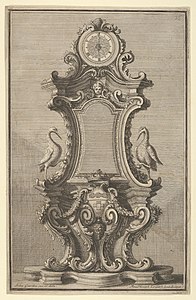 Baroque volutes on a design for a clock from 'Disegni Diversi', by Giovanni Giardini and Maximilian Joseph Limpach, 1714-1750, etching and engraving, Metropolitan Museum of Art
Baroque volutes on a design for a clock from 'Disegni Diversi', by Giovanni Giardini and Maximilian Joseph Limpach, 1714-1750, etching and engraving, Metropolitan Museum of Art
-
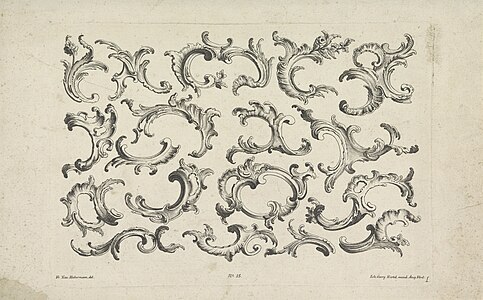 Combinations of Rococo C and S-shaped volutes, by Franz Xaver Habermann, 1731-1775, etching, Rijksmuseum, Amsterdam, the Netherlands
Combinations of Rococo C and S-shaped volutes, by Franz Xaver Habermann, 1731-1775, etching, Rijksmuseum, Amsterdam, the Netherlands
-
 Combinations of Rococo C and S-shaped volutes, by Franz Xaver Habermann, 1731-1775, etching, Rijksmuseum
Combinations of Rococo C and S-shaped volutes, by Franz Xaver Habermann, 1731-1775, etching, Rijksmuseum
-
 Combinations of Rococo C and S-shaped volutes, by Franz Xaver Habermann, 1731-1775, etching, Rijksmuseum
Combinations of Rococo C and S-shaped volutes, by Franz Xaver Habermann, 1731-1775, etching, Rijksmuseum
-
 Combinations of Rococo C and S-shaped volutes, by Franz Xaver Habermann, 1731-1775, etching, Rijksmuseum
Combinations of Rococo C and S-shaped volutes, by Franz Xaver Habermann, 1731-1775, etching, Rijksmuseum
-
 Rococo C and S-shaped volutes on a side table (commode en console), by Bernard II van Risamburgh, c.1755-1760, Japanese lacquer, gilt-bronze mounts and Sarrancolin marble top, Metropolitan Museum of Art
Rococo C and S-shaped volutes on a side table (commode en console), by Bernard II van Risamburgh, c.1755-1760, Japanese lacquer, gilt-bronze mounts and Sarrancolin marble top, Metropolitan Museum of Art
-
 Rococo C and S-shaped volutes in the library of Rolduc, Kerkrade, Germany, by Joseph Moretti, 18th century
Rococo C and S-shaped volutes in the library of Rolduc, Kerkrade, Germany, by Joseph Moretti, 18th century
-
 Māori volutes on a canoe sternpost, late 18th-early 19th century, wood and sheel, Musée du Quai Branly, Paris
Māori volutes on a canoe sternpost, late 18th-early 19th century, wood and sheel, Musée du Quai Branly, Paris
-
 Japanese volutes on a tsuba, unknown date, shakudo and gold, Walters Art Museum
Japanese volutes on a tsuba, unknown date, shakudo and gold, Walters Art Museum
-
 Neoclassical foliage volutes on a vase, by the Sèvres Porcelain Manufactory, 1814, hard-paste porcelain with platinum background and gilt bronze mounts, Louvre
Neoclassical foliage volutes on a vase, by the Sèvres Porcelain Manufactory, 1814, hard-paste porcelain with platinum background and gilt bronze mounts, Louvre
-
 Rococo Revival C and S-shaped volutes of a cartouche on the base of a nine-light candelabrum, 1835–1836, gilded silver, Metropolitan Museum of Art
Rococo Revival C and S-shaped volutes of a cartouche on the base of a nine-light candelabrum, 1835–1836, gilded silver, Metropolitan Museum of Art
-
Baroque Revival volutes of a dormer window (oeil-de-boeuf type) on the building of préfecture de police de Paris, Île de la Cité, by Victor Calliat, mid-19th century
-
 Neoclassical volutes of a pediment with acroteria of the Grave of Alexandrina Grejdanescu and Barbu Grejdanescu, Bellu Cemetery, Bucharest, Romania, unknown architect or sculptor, c.1871
Neoclassical volutes of a pediment with acroteria of the Grave of Alexandrina Grejdanescu and Barbu Grejdanescu, Bellu Cemetery, Bucharest, Romania, unknown architect or sculptor, c.1871
-
 Rococo Revival volutes on a wall in the George Severeanu Museum, Bucharest, unknown architect, c.1900
Rococo Revival volutes on a wall in the George Severeanu Museum, Bucharest, unknown architect, c.1900
-
 Rococo Revival volutes above the door of Avenue Kléber no. 47bis, Paris, unknown architect, 1908
Rococo Revival volutes above the door of Avenue Kléber no. 47bis, Paris, unknown architect, 1908
-
 Art Deco volutes on some decorative ironwork of the Madison Belmont Building (Madison Avenue no. 181–183) in New York City, by Ferrobrandt, 1925
Art Deco volutes on some decorative ironwork of the Madison Belmont Building (Madison Avenue no. 181–183) in New York City, by Ferrobrandt, 1925
-
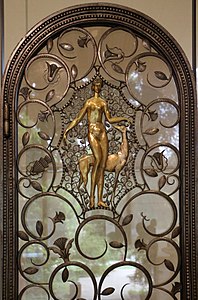 Art Deco volutes on a pair of elevator doors, by Edgar Brandt, 1926, wrought iron, glass, and patinated and gilded bronze, Calouste Gulbenkian Museum, Lisbon
Art Deco volutes on a pair of elevator doors, by Edgar Brandt, 1926, wrought iron, glass, and patinated and gilded bronze, Calouste Gulbenkian Museum, Lisbon
-
 Art Deco volutes on some ironwork of Avenue des Champs-Élysées no. 77 in Paris, unknown architect, (c. 1930)
Art Deco volutes on some ironwork of Avenue des Champs-Élysées no. 77 in Paris, unknown architect, (c. 1930)
-
 Art Deco volutes in a relief panel on Piața Mihail Kogălniceanu no. 1, Bucharest, unknown architect, c.1930
Art Deco volutes in a relief panel on Piața Mihail Kogălniceanu no. 1, Bucharest, unknown architect, c.1930
-
 Postmodern volutes of a vase inspired by the Ionic capital, designed by Michael Graves for Swid Powell, 1989, glazed porcelain, Indianapolis Museum of Art, Indianapolis, US
Postmodern volutes of a vase inspired by the Ionic capital, designed by Michael Graves for Swid Powell, 1989, glazed porcelain, Indianapolis Museum of Art, Indianapolis, US
-
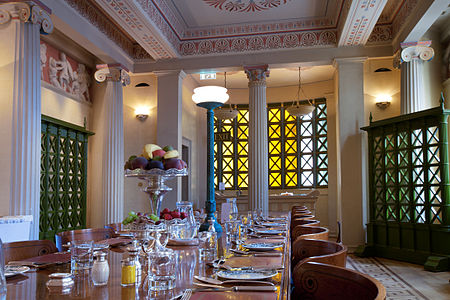 New Classical volutes of Ionic and Corinthian columns in the Gonville and Caius College Hall, Cambridge, UK, with capitals inspired by those from the Temple of Apollo at Bassae, by John Simpson, 1998
New Classical volutes of Ionic and Corinthian columns in the Gonville and Caius College Hall, Cambridge, UK, with capitals inspired by those from the Temple of Apollo at Bassae, by John Simpson, 1998
See also
References
- "Volute". A Dictionary of Architecture and Landscape Architecture. James Stevens Curl. Oxford University Press, 2006
- "Volute". The Concise Oxford Dictionary of Archaeology. Timothy Darvill. Oxford University Press, 2002
- Smith, David Michael (2017). Pocket Museum - Ancient Greece. Thames & Hudson. p. 30. ISBN 978-0-500-51958-5.
- "lyre". www.britishmuseum.org. Retrieved 30 July 2024.
- Smith, David Michael (2017). Pocket Museum - Ancient Greece. Thames & Hudson. p. 82. ISBN 978-0-500-51958-5.
- Watkin, David (2022). A History of Western Architecture. Laurence King. p. 38. ISBN 978-1-52942-030-2.
- Hugh Honour, John Fleming (2009). A World History of Art - Revised Seventh Edition. Laurence King Publishing. p. 147. ISBN 978-1-85669-584-8.
- "Temple of Apollo at Didyma". brown.edu. Retrieved 6 March 2024.
- Robertson, Hutton (2022). The History of Art - From Prehistory to Presentday - A Global View. Thames & Hudson. p. 323. ISBN 978-0-500-02236-8.
- Hodge 2019, p. 62. sfn error: no target: CITEREFHodge2019 (help)
- Rebold Benton, Janetta (2022). The History of Western Art. Thames & Hudson. p. 93. ISBN 978-0-500-29665-3.
- "Paire de Vases « Fuseau »". amisdulouvre.fr. Retrieved 10 May 2023.
- "47 bis avenue Kléber". bercail.com. Retrieved 18 September 2023.
- Criticos, Mihaela (2009). Art Deco sau Modernismul Bine Temperat - Art Deco or Well-Tempered Modernism (in Romanian and English). SIMETRIA. p. 189. ISBN 978-973-1872-03-2.
- Criticos, Mihaela (2009). Art Deco sau Modernismul Bine Temperat - Art Deco or Well-Tempered Modernism (in Romanian and English). SIMETRIA. p. 196. ISBN 978-973-1872-03-2.
- Gura, Judith (2017). Postmodern Design Complete. Thames & Hudson. p. 335. ISBN 978-0-500-51914-1.
External links
- [REDACTED] Media related to Volutes (architecture) at Wikimedia Commons
